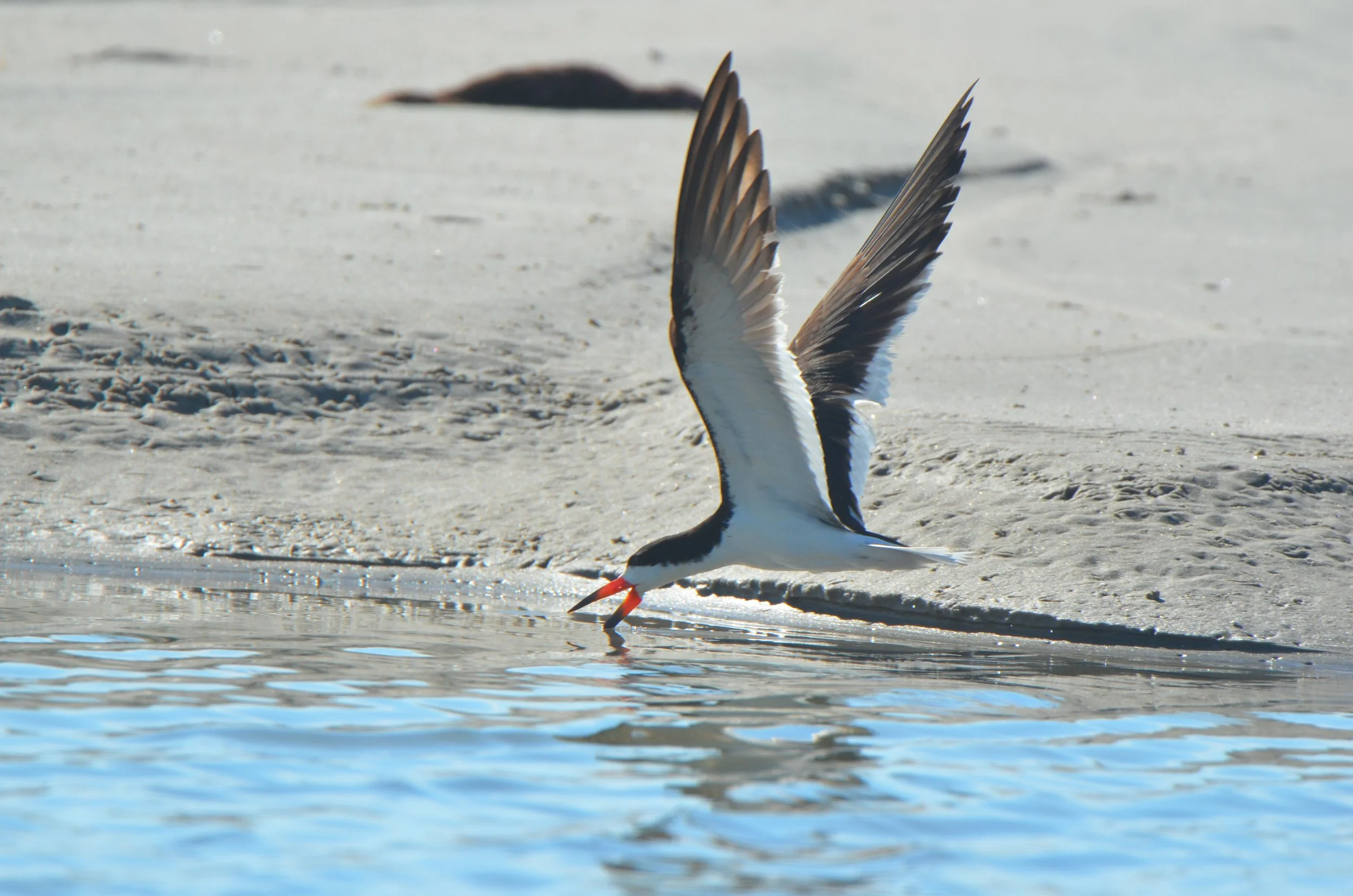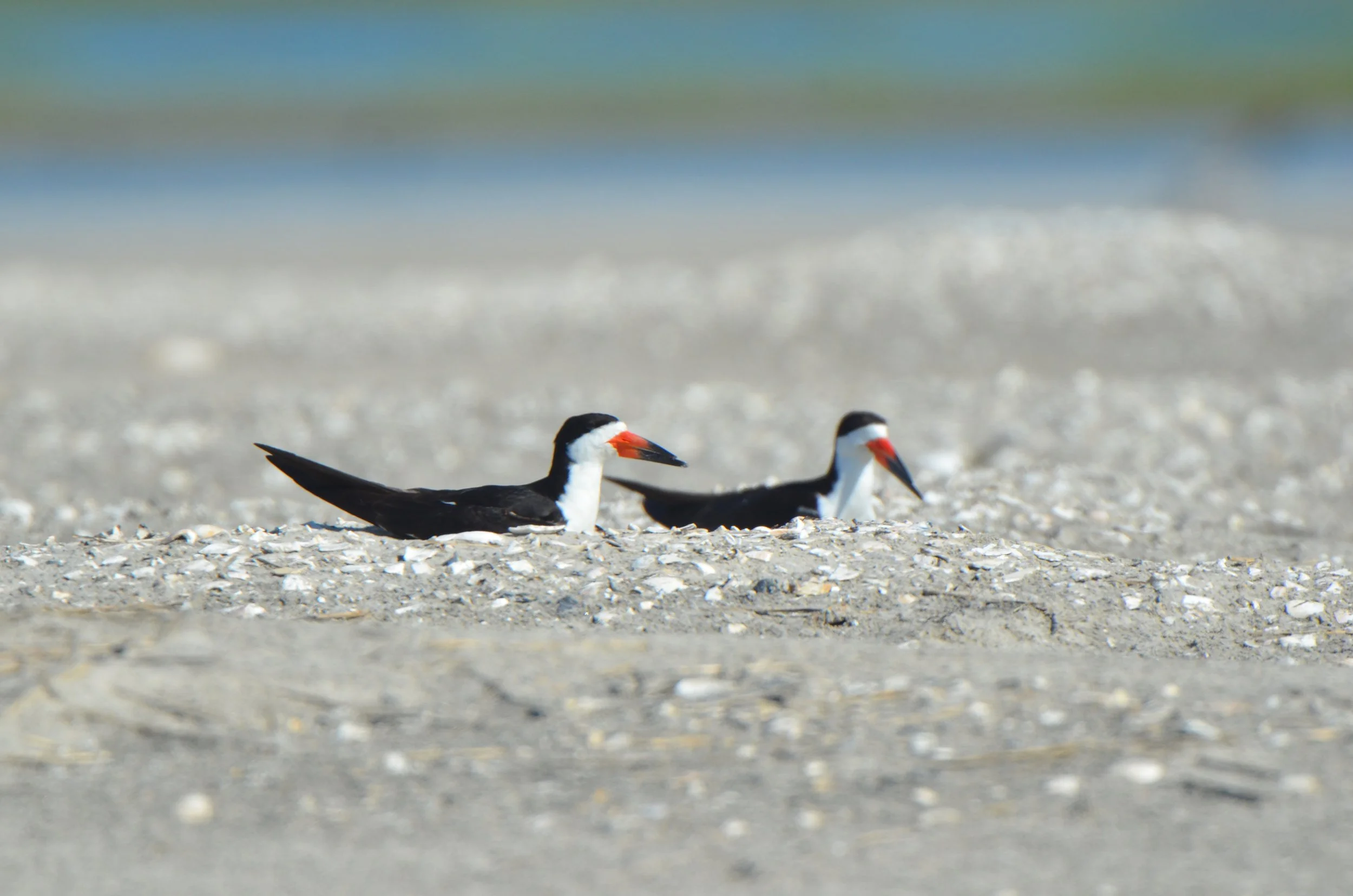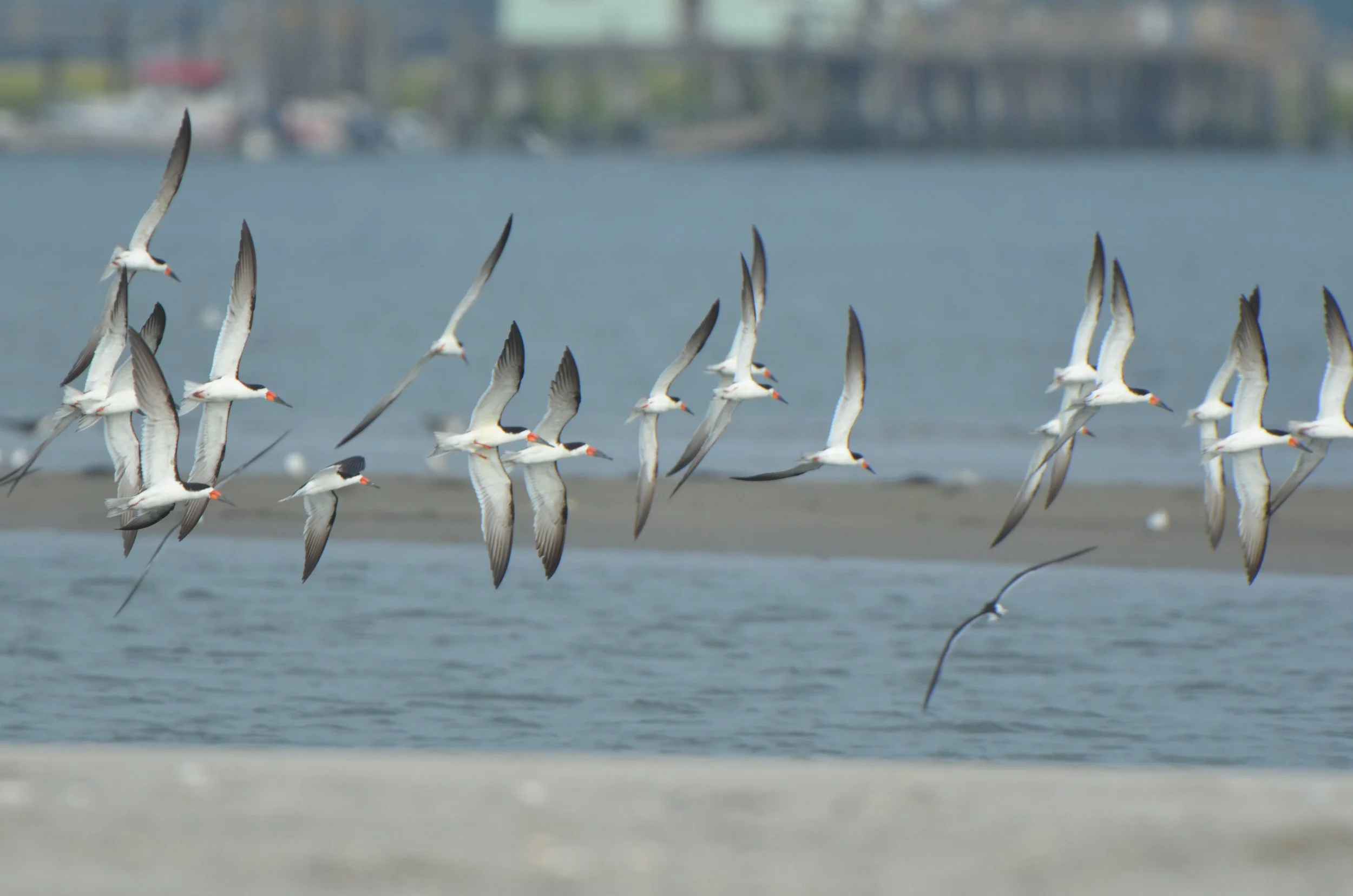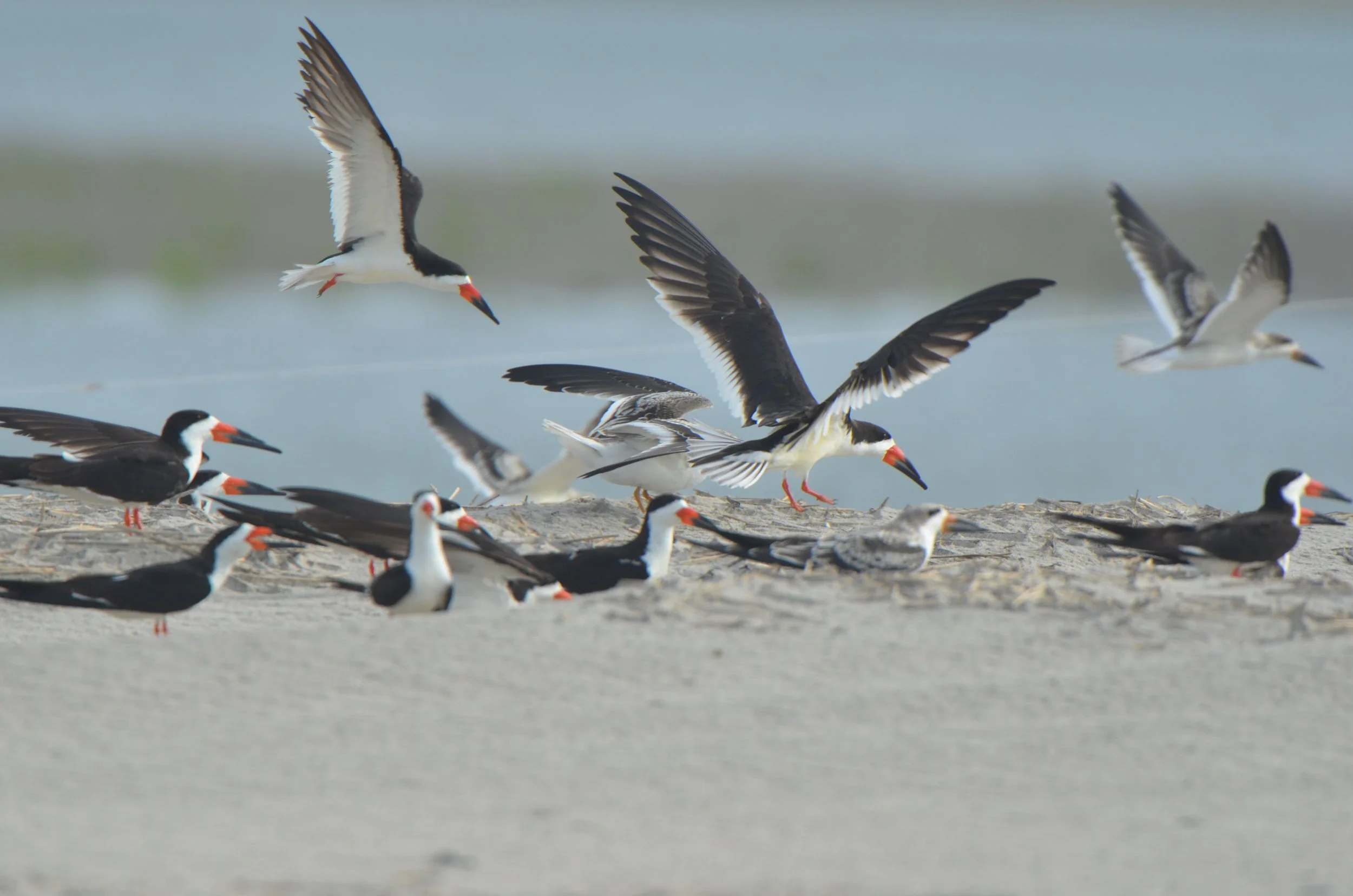The Barking Birds Among Us: Tracking and Protecting the Black Skimmers That Nest at Stone Harbor Point
Black skimmer skimming for food in the shallows at Stone Harbor Point.
By Dr. Lisa Ferguson of The Wetlands Institute
They bark. They hang out in large flocks on short orange legs by the water in the summer heat. And when they lift and swirl as a flock, they are a spectacle that can take your breath away.
If you pay close attention, you might notice some black skimmers are bigger (the males) than others (the females). In a rather unique approach to fishing, they glide over still waters of the slack tide with the lower, longer bill scraping the surface of the water, tracing lines as they search by feel for food. When they find their target, they snap their necks down to secure their prey. One fish at a time. Their large eyes with cat-like pupils and long slender wings equip them to work the waters under dim light when the fish make their vertical migration, putting them within reach of that skimming bill.
On Seven Mile Beach, we are lucky to showcase a colony of black skimmers at the south end of Stone Harbor Point. There is only a short list of other spots in New Jersey where this state-endangered seabird nests. Of the 2,341 skimmers present at nesting sites in New Jersey in 2024 (as estimated by New Jersey Fish and Wildlife in the 2024 New Jersey Beach-Nesting Bird Project Report), more than a third selected Stone Harbor Point as their spot – 898 skimmers, to be exact.
Skimmers tend to seek out-of-the-way locations, far from the crowds that might disturb their stations for warming eggs, guarding chicks, and catching rest on the shorelines. But if the conditions are right, they have been known to nest on busy beaches and in the marsh grasses, too. Their nest is a simple shallow scrape dug by foot, making the 3-4 eggs they so carefully tend within vulnerable to flooding from storms, tidal surges, land and aerial predators, and, perhaps no surprise, many of the activities we love the beach for, too. In 2024, there were only three active colonies in the state, the lowest number on record since 1976, which speaks to just how important it is to protect these sites.
Since 2015, black skimmers have been a focus of our work through the Research and Conservation Department at The Wetlands Institute. Each summer, in partnership with the Borough of Stone Harbor, our stewards keep a protective eye on the skimmers and their beach-nesting neighbors like piping plovers, American oystercatchers, and common terns. The stewards answer questions, educate, and direct people on routes less disruptive to the birds that are simply trying to raise their young in a crowded world.
This mission gets increasingly challenging as the young hatch and test their legs on the open beach, often seeking position on the water’s edge where the sand and updrafts are cooler. It gets hot on the upper beach, sometimes lethally so, which is why giving the skimmers and other beach-nesting birds the space to do their job protecting their nests and raising young is ultimately the goal of our stewards. For those of us who venture out to enjoy the beaches, picking a path that gives the birds and their nesting areas wider berth and choosing to follow dog rules goes a long way to making this job easier.
If you take a really close look at a lineup of skimmers, you might see some are touting a brightly colored band around their leg. Since 2017, our trained staff has been banding skimmers under our federal and state permits with a white three-character code engraved in a blue band, which happens to be New Jersey’s color in a coordinated system of band colors by state. We work in concert with New Jersey Fish and Wildlife on this project to individually mark skimmers so we can better understand the travels, habits, and survival of this species.
Most of the skimmers are chicks when we band them, because as you can imagine it is easier to catch a flightless bird. Skimmers begin breeding at 2-3 years old and often return to the same colony where they spent their days as a chick, so it is not uncommon for skimmers banded as chicks to return to nest and raise their young in New Jersey.
We share and receive information about which banded skimmers we see with the U.S. Geological Survey’s Bird Banding Laboratory and a network of partners and volunteers up and down the coast. What is remarkable is that of the now 364 skimmer legs banded in New Jersey, we have observations of 70% of the skimmers reported. The vast majority of these skimmers have been spotted along the coast of the United States, with 11 states checking in, but we have had observation reported from as far away as Mexico and Cuba to the south and Nova Scotia to the north. We are learning which beaches New Jersey skimmers prefer for rest during our winter months (turns out Florida), with rich marsh systems they feed in on their journeys north and south, and what threats they might be exposed to along the way. When hurricanes strike the coast of Florida, we worry about our New Jersey skimmers.
Taking our investigations to a new level, with backing from New Jersey Fish and Wildlife and philanthropic supporters of The Wetlands Institute, we have deployed lightweight GPS transmitters on 20 skimmers to study in greater detail where they go even when we are not able to watch, removing the bias linked to band data. These tracking devices are giving us insights into foraging locations, nocturnal roosts, and movements of individuals between colonies. We are finding that the differences between sexes does not stop with body size, but extends to where and how far they travel on the seascape.
These studies are helping to protect this species in New Jersey and across their range. The choices you make are helping, too. What more can you do?
Walk around flocks of birds.
If your movement disturbs their movement, you are too close.
Exercise your dogs away from areas where protected species nest and rest.
Look for and report bands. It’s a fun and rewarding way to spend your time and help science! Plus, you’ll learn the details of the birds you report.
Be mindful of your wake when piloting through the back bays and along coastlines. Vulnerable chicks and nests might be out of sight but not out of reach of your wake.











